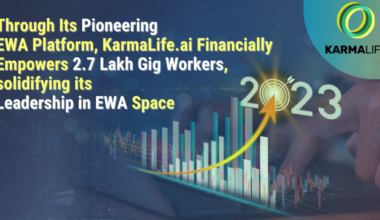The effects of the second wave of COVID-19 on micro, small and medium enterprises (MSMEs) are widely anticipated to be more harmful than those of the first wave. The government has rightly allowed more sectors to access the Emergency Credit Line Guarantee Scheme, but micro enterprises will still face challenges. Their unmet needs are still huge.
An article published in Mint on 6 May 2021 – ‘We must study the MSME credit gap before we can fix it’ by Deep Mukherjee – emphasises the scope of digital lending based on alternative data for the 27-29 million long tail of MSMEs with no access to formal credit. More importantly, there are roughly 400 million gig, contract and casual workers, many cash generators and spenders, who have no means to smoothen consumption in the face of volatile cash flows.
According to a study, 81% of gig workers saw serious declines in earnings due to the first wave of COVID-19, with almost 90% of them earning less than ₹15,000 per month. There is a compelling business case for digital loan providers (DLPs).
Technology available today enables DLPs to be more inclusive and lend to a large pool of customers, rather than only to the relatively affluent and ‘creditworthy’ customers. New data-pooling partnerships and dynamic underwriting models that assess everyday behaviour will be key. The African experience demonstrates 80% repayment predictability from mobile-generated social data.
Second, given the kind of unpredictability faced by the poor and informal segments, lenders should promote flexible solutions that are aligned with user needs by varying loan ticket sizes, tenors and repayment schedules. This allows, for example, daily loans for street vendors, weekly salary advances for gig workers, and quarterly harvest-linked farming loans. New data can also identify circumstantial versus intentional reasons for delayed repayments, offer more flexibility in resolution paths, and improve credit outcomes.
Third, low-income credit seekers place a hefty premium on being able to access finance quickly and conveniently. Digital technologies like eKYC and UPI, as well as emerging digital data pipelines, are facilitating reliable high-speed loans. Lenders should use this infrastructure to make their processes user-friendly.
Four, loans should be priced affordably. The annualized cost of capital for large banks is around 4-5%, whereas non-banking financial companies access funds at 8-15%. Beyond an initial demonstration period, fintech firms should be able to harness technology and data innovation to keep costs under 20%. The prevailing effective rates are often higher than this, especially for small and short loans, which disproportionately and negatively impact poorer users. This may reflect inefficiency and excessive value capture. Lenders should look beyond high interest rates and tap merchant revenues through cross-selling and embedded finance opportunities. The industry should also benchmark cost structures and monetization models to drive performance.
Five, opaque and complicated fee structures create a cognitive overload for less-literate users. Lender pricing often contains a slew of charges (processing fees, interest rates, late penalties, etc), with little or no clarity on the loan’s effective price. Simpler user-friendly models such as subscriptions should be the norm rather than the exception, as they are now.
Finally, there is an absence of traditional data for the underserved, be it credit scores, bank records, or even digital data trails (though this is now changing with smartphone penetration). Recent past behaviour—financial and non-financial—is therefore critical to understand and manage risk. Users can start their financial journeys with small loans and simple saving products before they graduate to sophisticated offerings. Over time, deep and diversified finance that integrates payments, credit, insurance, savings and pension will create true financial resilience and growth.
With 2,200 fintech enterprises and counting, the next decade will belong to business models that prioritize customer lifetime value over quick margins, so that vulnerable citizens can manage their finances, invest in their future and avoid devastating shocks. Venture capitalists, balance sheet funders, employers and channel aggregators must promote such an approach among DLPs.
Responsible fintech can create sustainable credit models to power a $5-trillion Indian economy, but concrete practices of ‘good governance’ will be prerequisites. This will not only lower greatly the burden on already-stretched regulators, but also avert a situation of regulatory overkill that could apply indiscriminately to all players.
This article was first published on the Mint newspaper, on June 7, 2021.
V. Anantha Nageswaran and Badal Malick are, respectively, a member of the Economic Advisory Council to the Prime Minister and a founder at KarmaLife, a fintech solution for non-salaried workers.






